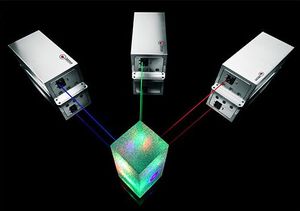Distance Metrology
Laser Tracking of remote subjects
- Measuring distances or object lengths
- Providing positions over long distances
- Used in geodesy, sports, hunting or military
- Achieves millimeter accuracy
Using of Laser rangefinders
Laser rangefinders can be used to monitor or measure distances or object lengths. They can also provide positional locations over long distances, e.g. several kilometers, without physically touching the observed object. The laser range finders are regularly used in geodesy, sports, hunting or military. Usually the distances are measured with accuracies of up to a millimeter, whereas the measured object can even be in motion. In addition, measurements on natural surfaces with low reflectivity are also possible.
Laser tracker measurement
To take a laser tracker measurements a technician first installs a laser tracker on a tripod with an unobstructed view of the object to be measured. The technician then moves a target from the base of the laser tracker to the object to be measured, moving smoothly and allowing the laser tracker to follow the movement of the target. Afterwards the technician places the target against the object and takes measurements at selected points, sometimes by a remote control device. The measurement data can br imported into different types of software to plot the points or to calculate deviation from the correct position.
The targets are known as "retroreflective" since they reflect the laser beam in the same direction it came from (in this case, back to the laser tracker). One type of target in common use is called a spherically mounted retroreflector (SMR), which resembles a ball bearing with mirrored surfaces cut into it. All of these systems commonly use a highly coherent laser or laser diode either in the invisible infrared regime or in the visible regime commonly at 633 nm. For this wavelength bulky HeNe lasers were commonly used, which nowadays are being replaced by compact frequency-stabilized diode lasers at 633 nm.

